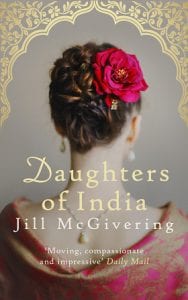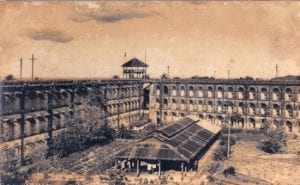The Bigger Picture – a guest post from Jill McGivering
Today we’re welcoming Jill McGivering to the blog, to discuss some of the inspiration behind her latest book, Daughters of India, which came out this week.

When I was based in India as a journalist some years ago, a visiting British colleague told me a story. She’d just been to the office of an Indian colleague in Calcutta and spotted on the wall a large framed map of a chain of islands.
“Aren’t those the Andaman Islands?” she asked him.
He confirmed they were.
She chatted on: “So what’s your interest in the Islands?”
His face clouded. “My Great-Grandfather was held in the Cellular Jail there, as a political prisoner,” he said coldly. “By the British.”
“Oh.” She looked sheepish.
“What makes you ask?”
“Well.” She hesitated. “My Great-Uncle was the prison governor.”
Fortunately they both managed to laugh.
It was an extraordinary coincidence. And the story fascinated me.

For one thing, although I had read and heard a great deal about the British Raj, the decades of British colonial rule which ended with Indian independence in 1947, this was the first I’d heard of the British penal colony on the remote Andamans, far out in the Bay of Bengal, sometimes described as Britain’s Devil’s Island. For decades, murderers and political prisoners, involved in fighting British rule, were shipped off to the notorious Cellular Jail there.
So far, so interesting but I’m a novelist, not an historian. What really intrigued me was the fact that these two people had ancestors on opposing sides of a bloody and bitter divide who must have viewed their shared world through completely different eyes.
What conversations would those two men have, British colonial governor and anti-British activist, if they were left alone in a room together? What would the women closest to them make of each other?
It was this spark which sent me to the British Library to look for unpublished British memoirs of the period, including a wonderful account of colonial life on the Andamans by my colleague’s Great-Aunt, the wife of the prison governor she mentioned.
I learnt that this remote community was seen as the back of beyond by many British serving in India. Stories circulated of British officials and their wives being attacked or even killed there by convicts.
Even so, prisoners were regularly employed as servants in British households (with the one stipulation that a convicted poisoner must never work as a Cook). One woman of the period wrote with confidence that once a murderer was caught and punished, he was most unlikely to kill again, adding: we grew very fond of some of our murderers.
Despite rather basic living conditions for British Colonial officers, a picture emerged of a routine enlivened by beach picnics, tennis parties and dance suppers at the Club. The women offered tips on running a colonial household here, from managing mosquitoes to recipes for exotic local fish.
Other writers, including some former Indian prisoners, described the Cellular Jail itself, from its interior to its regime. The harsh chain-gangs in which prisoners were put to work. The executions. And the sometimes fatal force-feeding of political prisoners who went on hunger strike.
Does all this historical research matter? Well, yes and no.
I’m setting a novel in a particular period and place and I want it to be accurate. But it’s also not the point. What the novel is really about is not the historical but the universal and themes which still resonate today. The fact that two different people can have utterly opposing visions of what is right and whether killing in the name of a political cause can ever be justified.
One thought on “The Bigger Picture – a guest post from Jill McGivering”
Leave a Reply
You must be logged in to post a comment.



What a fascinating post. I can understand how the anecdote at the start about the two ancestors would be the starting point for needing to know more and for a story to begin to grow. Daughters of India is currently working its way up to the top of my TBR pile and, having read this blog, I’m looking forward to it even more.